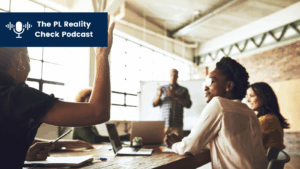The PL Reality Check Podcast
Interview Transcript
Joslyn:
Welcome to the PL Reality Check, brought to you by Rivet Education. In just a few minutes, we’ll strip away the buzzwords and get real about professional learning.
Each episode brings insider insight from experts and partners, so you can make smarter, faster decisions for your district.
My name is Joslyn Richardson, the Director of the Professional Learning Partner Guide here at Rivet.
Today, we’re chatting with Shira Hillyer, founder of Elevating Standards. And we’re talking with her about professional learning for educators implementing research-based instruction grounded in the science of reading.
Thank you so much, Shira, for joining us. Before we get started, can you share a little bit about Elevating Standards and the work that you do?
Shira:
Sure, yeah, thanks for having me. So, Elevating Standards was founded in 2021, and it’s really based on this fundamental idea that materials matter. So, what materials teachers are using and how they’re being supported in using those materials makes a big impact on whether and how students learn to read.
My background, personally, is in elementary literacy, and I have the opportunity to work with consultants across grades K-12 to support states and districts regarding their guidance and professional learning around the adoption and implementation of instructional materials and evidence-based practices that helped more students learn to read and write.
And I’m excited to be here. I think, Joslyn, you and I first met a couple of years ago.
Uh, just to talk about the very early ideas for the Science of Reading badge, so I’m excited that we’re here, and I’ve had the opportunity to work with you, and make this vision come to fruition.
Joslyn:
Yes, developing the badge has been a great learning experience for our team. We’ve learned lots of things, and so just love that we’re able to, you know, have this so that professional learning providers can really provide the support that educators and leaders need when implementing curriculum and instruction that is grounded in the science of reading research, like, really making those connections for them.
So that leads me to our first question. With the new necessary requirements in the states shifting across the country in recent years in response to the literacy crisis, we see that there are many providers who claim to be science of reading aligned.
From your perspective, what’s the biggest misconception districts have about science of reading professional learning?
Shira:
Yeah, I’ll name two that I think I hear a lot. So, one of the biggest misconceptions about the science of reading in general is that it’s a specific program, or a set of standards that teachers need to be trained on. So, I think sometimes the misconception regarding professional learning is this idea that we need to buy a new program called Science of Reading, and then train teachers on it.
And that’s not the case, right? So the science of reading is not a specific pedagogy or a program that can be adopted.
The term science of reading does have different definitions and applications, and Tim Shanahan has some really helpful blog posts about this, if you want to read more. So, I often find that it’s helpful to refer to the Reading League’s definition, which states that science of reading is a vast, interdisciplinary body of scientifically-based research about reading and issues related to reading and writing.
So the idea is that equipping educators with an understanding of how skilled reading and writing develops and enhancing teachers’ awareness of approaches that are supported by evidence, and ensuring that they have instructional materials that are grounded in the science of reading is going to help teachers be more supported in ensuring that all kids learn how to read.
And I’ll just name one more quick misconception that I often hear, which is that the science of reading is only about phonics, and that if you teach phonics, you’re teaching, quote, the science of reading.
And I just want to name, there is so much helpful research in the last 30 years. I mean, before that, but in particular, in the last 30 years, in my opinion about what kids need to read, and explicit phonics instruction is there, but it’s just one piece of the puzzle.
So… when we talk about PL. Teachers are not teaching, quote, the science of reading.
Teachers are teaching kids to read. The science of reading is the body of research that informs what we know about how kids learn to read and write, and where and why they may experience challenges.
So when we talk about PL for teachers, we’re talking about teaching teachers about the research and how it connects to evidence-based instruction for kids.
Joslyn:
Thank you for sharing that. It’s very important that all educators at all levels have this understanding.
So, in regards to science of reading educator training, what would you say are some common warning signs that the science of reading training might not actually change classroom practice.
Shira:
I think if teachers walk out of a PD session. Thinking or leaving feedback that sounds like, what do I do with this information? Or, oh, this won’t work for my students, that’s a warning sign.
What we’ve been… what I’ve been hearing, and many of my colleagues have been hearing from teachers over the last several years, is a request for a deeper understanding of how the research connects to practice.
So, if we assume for the purposes of this badge that teachers have high-quality instructional materials they’re using, and we know that off-the-shelf curricula don’t necessarily do all things for all children, but, if teachers have HQM they’re using, then what districts should be able to expect from their science of reading PL is that it’s equipping teachers with an understanding of the research and how that research should undergird the design of their HQIM, and how teachers can implement evidence-based practices using their HQIM.
So, the hope is that that connection between research and practice will ultimately lead to shifts in student learning.
Joslyn:
Absolutely. That practicality in the classroom based on the theoretical knowledge is absolutely essential.
We know that research shows that student learning can be improved with the usage of high-quality instructional materials, or HQIM., so why is alignment to HQIM in day-to-day instructional work critical for science of reading professional learning to be effective?
Shira:
Yeah, I think that speaks to what I was just saying a moment ago, which is… you know, when teachers are able to engage in unit and lesson internalization with their HQIM, with this deeper knowledge of the research, then they’re equipped with this understanding of the scope and sequence, and the text selection. And the use of different types of texts and instructional routines, and daily lesson content. And how all of that is driving towards the development of skilled readers and writers.
So, understanding the research empowers educators with planning for how they’re going to implement these materials in so many different ways. For example, how they will notice and attend to the student practice opportunities in their curriculum, which is super important. And, for example, when and how to differentiate and scaffold in response to students’ learning needs.
So I think the connection here is where we, like I said in the previous responses, where we really are able to see that this work is going to lead to shifts in student learning.
Joslyn:
Okay. All right, we have reached our last question, and there’s been some great information shared so far.
Now, this question may be a tough one, but, if you could summarize in one sentence how to avoid weak ELA professional learning, what would you say?
Shira:
I would just be wary of anything that promises immediate impact on student outcome data, like state summatives, because the process of shifting teacher practice takes time.
Time, and any new initiative requires a lot of system-wide enabling structures, professional learning, collaboration.
And a number of other things in order to support. Effective implementation.
Joslyn:
Thank you. Well, there you have it, folks. Thank you so much, Shira, for sharing your insight into this very important topic.
Listeners, tune in for part two of our conversation, Cutting the Noise: Three Questions Every District Leader Should Ask about Science of Reading Professional Learning.
You can read more about the Science of Reading Badge and its development in Shira’s blog post: Is This PL Really Aligned to the Science of Reading? Now There’s a Way to Know.





